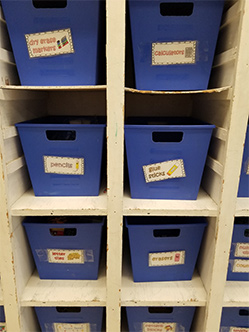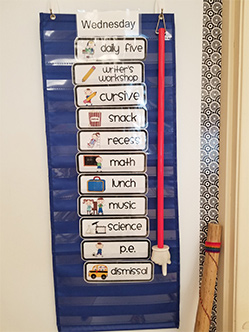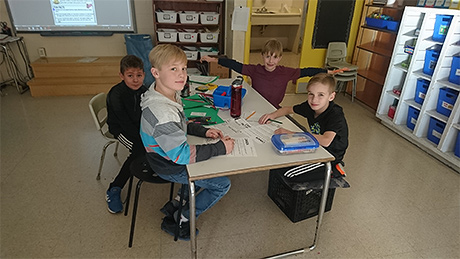During my podcast with Jana Nicol, she provided some wonderful examples of how she got started with the UDL framework. These included the organization of her classroom supplies, her use of the classroom schedule, and her adoption of flexible seating. Each were quality environment strategies. The difference, though, is how she used the framework to determine the design of each item. Below, I break down the three examples and include the UDL guidelines associated with her decisions.

What teacher doesn’t love an organized space, especially when your classroom isn’t particularly large? And while Jana teaches 3rd grade, many of the names associated with classroom supplies are part of students’ day-to-day language. She recognizes the variability she knows will be present. She knows that some of her learners might struggle when scanning the bins to locate the correct supplies. Knowing about variability also leads her to design other presentation and use strategies. The signs on her bins include the picture of the item (Perception and Language & Symbols). To what end? She wants her learners to be motivated and self-driven in their use of the supplies (Self-Regulation and Executive Functions). She wants to open the doors to creativity when they are working on projects (Expression & Communication) instead of requiring them to stop, seek permission, and potentially lose their creative idea while waiting to get the supply they need. And, instead of waiting, they can stay in their zone of excitement and productivity (Sustaining Effort & Persistence). The pure freedom learners have to choose the supply they think they need provides them with more choice and autonomy (Recruiting Interest), leading them to experience both success and challenge based on their choices (e.g., have you ever used a glue stick when you should have used masking tape?).

When I was an 8th grade collaborative special education teacher, students came to my room during two different periods a day. I always wrote a schedule on my board. I knew that helped my students (and me), but I didn’t know why it helped them. UDL helps me understand why.
Students know what is coming, which can help them understand the flow of the class (Sustaining Effort and Persistence) and know what’s coming next. For some, knowing the schedule order provides them with a sense of security (Recruiting interest) and helps them regulate their emotions and reactions toward specific subjects or what they perceive as activities connected with those subjects or activities (Self-regulation). Nicol’s schedule provides images, written words, and she reads the schedule out loud (Perception and Language & Symbols). She ensures her students understand the pattern of the day (Comprehension). By discussing the schedule, learners also have the opportunity to think through their day and plan how they will stay on task, work with others, or meet other goals (Executive Functions). Posting the schedule is a first step, but it is how the schedule is used in the environment that opens opportunities to learners. When you understand the guidelines, you can investigate how you might use a simple organizational structure in a way that benefits more of your learners in a more effective way.

Flexible seating is a popular topic and has been shown to be a promising structure for learning. In this podcast, we talked not only about the different types of seating learners could choose, but that they also chose where they worked and, when applicable, with whom they worked. It takes careful planning and execution and the UDL framework can help you do both, just as it helped Jana.
As Jana shares during the podcast, her students love choosing where they are going to work (Recruiting Interest). They are able to work alongside one another (Sustaining Effort and Persistence) and they help keep one another on track (I’m making an assumption here, but it fits with how Jana designs her classroom) (Sustaining Effort and Persistence and Self-Regulation). Students who might experience a learning barrier due to the physical set-up of the space can be provided with options and opportunity when there is flexible seating (Physical Action).
Toward the end of the podcast, Jana used a word that is one of the underlying components of UDL: flexibility. When we design environments that allow for learner choice – we build in flexibility – we see them grow. They now have to make decisions as to what is going to benefit them most. Which supply will help them accomplish what they’ve set out to do? How they will manage their needs as they relate to the schedule? And, which seating type and what location will help them reach their goals? These types of decisions are what help our learners become expert learners, and that is the ultimate goal of UDL.
